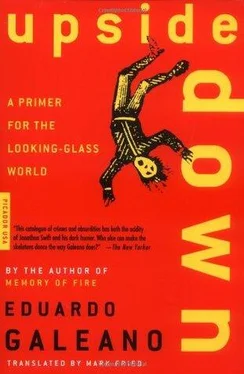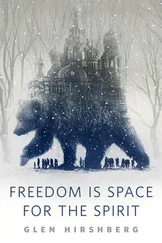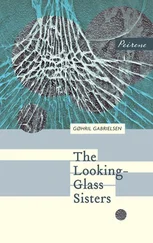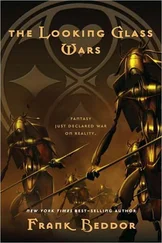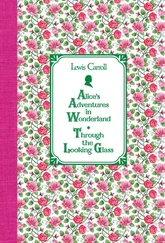Education
Near Stanford University I visited a smaller university that offers courses in obedience. The students, dogs of all races, colors, and sizes, learn to stop being dogs. When they bark, the professor punishes them by squeezing their snouts with her hand and yanking painfully on collars made of sharp steel points. When they remain quiet, the professor rewards their silence with treats. That is how she teaches them to forget how to bark.

Driven out by the ruin of their lands and the poisoning of their rivers and lakes, twenty-five million people are wandering about, looking for their place in the world. According to the most credible forecasts, in the coming years environmental degradation will be the principal factor causing an exodus of people from the countries of the South. And the countries that smile so nicely for the pictures, those happy protagonists of one economic miracle or another, think they have paid the toll, have passed the pole, and are on a roll, but they are already paying the price of their great leap to modernization: in Taiwan a third of the rice crop is inedible because it’s poisoned with mercury, arsenic, or cadmium; in South Korea the water from only a third of the rivers is drinkable. There are no longer edible fish in half the rivers of China. In a letter he was writing, a Chilean child drew a picture of his country: “Ships depart filled with trees, and ships arrive filled with cars.” Chile today is a long highway bordered by shopping malls, arid lands, and industrial forests where no bird sings; the trees, like soldiers at attention, march off to the world market.
View of Dusk at the End of the Century
Poisoned is the earth that inters or deters us.
There is no air, only despair; no breeze, only sleaze.
No rain, except acid rain.
No parks, just parking lots.
No partners, only partnerships.
Companies instead of nations.
Consumers instead of citizens.
Agglomerations instead of cities.
No people, only audiences.
No relations, except public relations.
No visions, just televisions.
To praise a flower, say: “It looks plastic.”
The twentieth century, a weary artist, ended its days painting still lifes. The extermination of the planet spares no one, not even the triumphal North that contributes the most to the catastrophe and, at the hour of truth, whistles and looks the other way. At the rate we’re going, it won’t be long before we’ll have to put up new signs in maternity wards in the United States: Attention, Babies: You are hereby warned that your chance of getting cancer is twice that of your grandparents. The Japanese company Daido Hokusan already sells air in cans, two minutes of oxygen for ten dollars. The label assures us: This is the electric generator that recharges human beings.

Wild Blue
This sky never grows cloudy; here it never rains. On this sea no one ever drowns; this beach is free of theft. There are no stinging jellyfish, no spiny urchins, no bothersome mosquitoes. The air and the water, climatized at a temperature that never varies, keep colds and flus at bay. The dirty depths of the port are envious of these transparent waters; this immaculate air mocks the poison that people in the city must breathe.
The ticket doesn’t cost much, thirty dollars a person, although you pay extra for chairs and umbrellas. On the Internet, it says: “Your children will hate you if you don’t take them…” Wild Blue, the Yokohama beach encased in glass, is a masterpiece of Japanese industry. The waves are as high as the motors make them. The electronic sun rises and falls when the company wishes, and the clientele is offered astonishing tropical sunrises and rosy sunsets behind swaying palms.
“It’s artificial,” says one visitor. “That’s why we like it.”
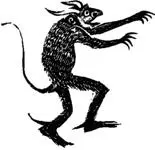
News
In 1994 in Laguna Beach, southern California, a deer came out of the forest. Galloping down the street, the deer was struck by a car. It leapt over a fence, crashed through a kitchen window, broke another window, threw itself off a second-floor balcony, burst into a hotel, and, like a bullet stained red with blood, raced past the astonished patrons of beachfront restaurants before plunging into the sea. The police trapped it in the water and hauled it onto the beach, where, bleeding profusely, it died.
“He was crazy,” the police explained.
A year later in San Diego, also in southern California, a veteran stole a tank from an arsenal. Driving the tank he crushed forty cars, damaged several bridges, and, with police cruisers in hot pursuit, ran down whatever crossed his path. When he got stuck on a steep rise, the police climbed on the tank, forced open the hatch, and plugged this ex-soldier full of bullets. TV viewers saw the entire spectacle live and direct.
“He was crazy,” the police explained.
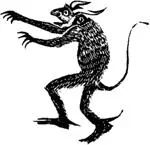

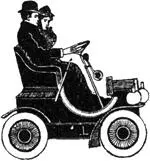
Human rights pale beside the rights of machines. In more and more cities, especially in the giant metropolises of the South, people have been banned. Automobiles usurp human space, poison the air, and frequently murder the interlopers who invade their conquered territory — and no one lifts a finger to stop them. Is there a difference between violence that kills by car and that which kills by knife or bullet?
THE VATICAN AND ITS LITURGIES
Our age abhors public transportation. In the middle of the twentieth century, Europeans used trains, buses, subways, and streetcars for three-quarters of their comings and goings. Today the figure is a quarter. That’s still high compared with the average for the United States, where public transportation, virtually eliminated in most cities, accounts for only 5 percent of all transportation.
Henry Ford and Harvey Firestone were good friends back in the twenties, and they both got on well with the Rockefellers. Their affection for one another reinforced a mutuality of interests that went a long way toward dismantling the railroads and creating a vast network of roads, then highways that spanned the United States. With the passing years, the power of car, tire, and oil magnates has grown ever more ruinous. Of the sixty largest companies in the world, half either belong to this holy alliance or work for it.
Today’s high heaven, the United States, has the greatest concentration of cars and the greatest quantity of weapons. Six, six, six: of every six dollars spent by the average North American, one is for the car; of every six hours of life, one is spent traveling in the car or working to pay for it; and of every six jobs, one is directly or indirectly related to the car, and another to violence and its industries. Each murder by cars and guns, of people and of nature, adds to the gross national product.
Читать дальше
